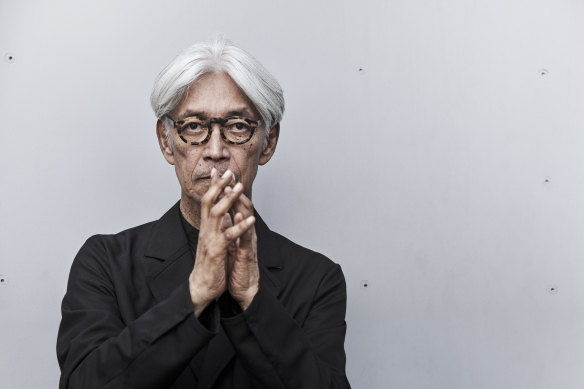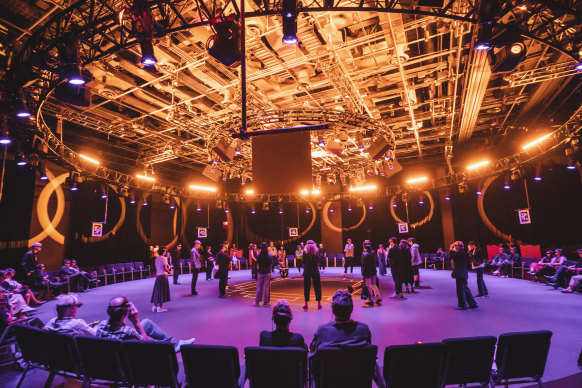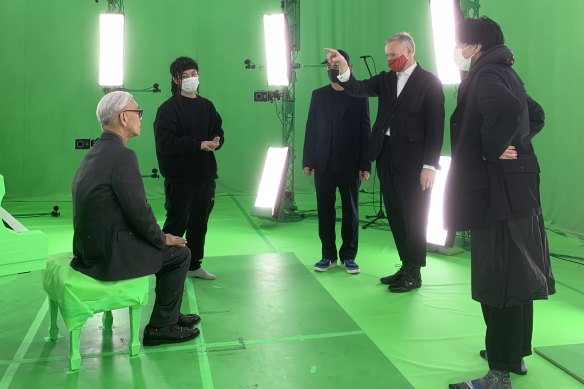Technology brings a music icon back to life. The heart does the rest
I wept during this extraordinary immersive encounter with Ryuichi Sakamoto, which comes to Melbourne next year.
Artist and composer Ryuichi Sakamoto – once described as the “godfather of electronic pop” – appears, seated at a grand piano, dressed in black, with his trademark mop of silver hair and glasses, and begins to play. Over the course of an hour, he performs many of his best compositions, along with some never before heard by an audience.

Ryuichi Sakamoto found out his cancer had returned during the first day of filming.Credit: Luigi & Iango
The beauty and power of his work is underlined by the pared-back, intimate setting; only 100 people are here to witness the tenderness with which he plays and the emotion evoked is visceral. Of course, he is no longer with us: Sakamoto died in March last year.
The award-winning composer, perhaps best known for film scores including The Last Emperor and Merry Christmas Mr. Lawrence, is brought to life in KAGAMI, a “Mixed Reality” production that makes its Australian premiere at Melbourne’s Asia TOPA festival next year. Devised by Sakamoto in collaboration with Tin Drum studios, it is shot by 48 cameras, including in 4D. You watch it wearing special glasses that make it seem like you’re in the room with Sakamoto.

KAGAMI at The Shed, New York, in 2023.Credit: Ryan Muir
It is incredibly moving – I wept, several times when I saw the production in Singapore earlier this month. When I share that detail with Todd Eckert, head of Tin Drum, he beams at me across Zoom. That’s exactly what they wanted, he says.
Music is elemental to how Eckert sees the world. “I’m really motivated by what human beings can do that brings us to this kind of elevated state,” he says.
“Ryuichi played with an elegance and a sincerity that represented how I wanted the world to be, and that relationship with the piano was so singular. I had to figure out a way to present for everybody forever, not an artefact of something they went there to see, but to have their curiosity and their agency inform the experience that they had.”
Filming began in December 2020, and the fact Sakamoto died midway through making the project, aged 71, adds poignancy to the performance. First diagnosed with cancer in 2014, “Ryuichi found out the morning that we started [filming] that the cancer was back and they were going to have to operate immediately,” says Eckert. “There is a gravity to his performance, the songs are slower – particularly in retrospect – you feel it very deeply, but in the room on the day, I just thought, ‘OK, he is feeling every single note’.”
There was also a visual change to his playing, according to Mary Hickson, Tin Drum’s chief creative officer. He crouched down lower over the piano, she says.
Only Norika Sora, his wife and manager, knew what was going on. “And, of course, less than two weeks after we wrapped, Ryuichi went into the hospital, and he didn’t come out for over a year,” Eckert says.

Filming KAGAMI with the green screens as backdrop.Credit: Courtesy of Tin Drum
The name behind about 50 film and television soundtracks,Sakamoto won an Oscar (for The Last Emperor), a BAFTA, a Grammy, and two Golden Globe Awards. He was a musical shape-shifter, always evolving, with a lifelong interest in technology. He was one of the first artists to play with sampling, and his band, Yellow Magic Orchestra – inspired by German electronica group Kraftwerk – was huge in Japan.
Sakamoto was obsessed with sound, recording things like rain falling and other natural phenomena and later going on field trips to places including Antarctica to record samples. “You have to open your ears all the time because anything could happen unexpectedly,” he said of his approach. “Anything can be music.”
He played many instruments on his dozens of albums and collaborated with artists such as David Bowie, David Sylvian and Iggy Pop, and reportedly started playing piano aged just three. When he died, NPR called him “a godfather of electronic pop”.
Eckert and Sakamoto were friends for years before KAGAMI was mooted. The prototype was Marina Abramovic, The Life, a 19-minute performance piece featuring the famous Serbian artist.
“I would describe him as devoid of cynicism and very much of the curiosity and excitement about the world that we associate with being children,” Eckert says. “Besides being a genius there was a great purity to him.”
It’s hard to encapsulate the power of the show, which is part of Asia TOPA’s focus on creative elders. A joint initiative of Arts Centre Melbourne and the Sidney Myer Fund, Asia TOPA showcases arts, culture and ideas from across the Asia-Pacific. It’s only the third staging of the multi-disciplinary triennial, the last of which was disrupted by COVID-19 lockdowns.
Hickson makes the point that unlike other technologies that take you somewhere else, Mixed Reality keeps you in place. While virtual reality immerses the user within a digital environment, augmented reality keeps the user’s field of view in the physical environment while adding digital overlays; Mixed Reality combines both.
“You can literally do anything in there, you can break the floor and break the ceiling, you can create a whole world,” says Hickson. “And you’re not in a virtual reality world, you’re grounded, we’re bringing something else into the space you’re in.
“It’s all about Ryuichi and the energy and humanity of him, it’s like it’s just the two of you, he becomes real to you, there’s something really weird that happens that’s really nice,” she says. “I think he just operated on a different plane, which made it easier for us … It feels almost spiritual.”
More footage of Sakamoto was captured than has been used in KAGAMI, so it’s possible we will see a sequel to the show. Other Tin Drum works in the pipeline can’t be revealed but Eckert admits someone pitched the idea for a project featuring the late Dame Maggie Smith a few years ago. “We weren’t able to make it work, and I probably didn’t push hard enough ...” he says, obviously regretful. “And then she died, and I thought, ‘you jerk, how did you not figure out a way to make that?’
“Every element of human endeavour, if it comes from a place of sincerity, is worth capturing with as much of the authentic human spirit as you possibly can. So that’s what drives me, that’s why I want to do this.”
According to Eckert, Sakamoto had to choose this particular project over a lot of other work. “And he made the comment a few different times, ‘But this will last forever’, and so I think he would feel that it fulfilled why we did it in the first place. And I think he would be – maybe is – proud of it.”
KAGAMI runs from February 19 to March 16, 2025, at the Melbourne Exhibition and Convention Centre, as part of Asia TOPA, from February 20–March 10, 2025.
The writer travelled to Singapore as a guest of Arts Centre Melbourne.